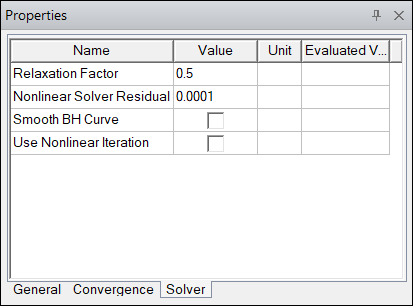AC Conduction Solver Settings
- For 2D and 3D designs, enter a frequency value in the Adaptive Frequency text box, and select the desired units. Use of variables and expressions are also supported.
- For 3D designs, enter a value in the Nonlinear Residual text box. This value specifies how close each solution must come to satisfying the equations that are used to compute the electric field.
- If desired, you can Import Mesh.
- For 2D and 3D designs, selecting the Number of Nonlinear Iterations check box allows you to set both a Minimum iteration number to avoid non-converged solution, and a Maximum iteration number to avoid taking too much computation time. These values must be integers greater than 1. The default values for Minimum and Maximum are 2 and 50, respectively. The Maximum number should be greater than the Minimum number.
- For 2D designs, the Thermal Two-Way Coupling\Relaxation setting can be used to improve two-way coupling convergence by applying the relaxation factor to the temperature field. When the thermal modifier takes on a nonlinear form, the convergence of the solution field in Maxwell's equations may fail during two-way coupling iterations. With nonlinear iterations, using an under-relaxation factor can mitigate the risk of overshooting in the property updating process.
- applicable to all Maxwell 2D designs,
- applicable to both geometry modes (Cartesian XY and Cylindrical about Z),
- does not support non-intrinsic and intrinsic variables.
The range of the relaxation factor is from 0 to 1. In general, a smaller relaxation value helps convergence, but may increase the total number of iterations. The default relaxation factor is 1.0.
The Thermal Two-Way Coupling\Relaxation setting is applicable only when Enable Feedback is checked in Temperature of Objects window, which invokes two-way coupling instead of one-way coupling. The relaxation setting is
If activated in the Solve Setup window, the Relaxation Factor is also available in the Solve Properties window:
